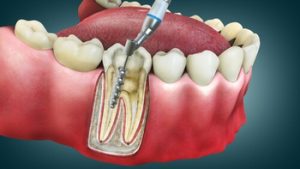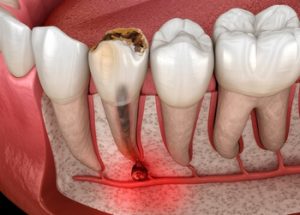If you’re experiencing a sore tooth after root canal treatment, you’re not alone. While a root canal procedure is meant to relieve tooth pain, it’s not uncommon for patients to report lingering discomfort for days or even weeks. The question is, what’s normal and what needs attention?
This comprehensive guide walks you through the causes, symptoms, and solutions for post-root canal discomfort. We’ll also explore what a failed root canal feels like, how to spot a missed canal, and when it’s time for further evaluation by a dentist.
Why Do You Need a Root Canal?
 A root canal treatment is necessary when the pulp chamber inside a natural tooth becomes infected or inflamed. This soft tissue contains nerves and blood vessels, which are vulnerable to damage from tooth decay, cracks, trauma, or an infected pulp.
A root canal treatment is necessary when the pulp chamber inside a natural tooth becomes infected or inflamed. This soft tissue contains nerves and blood vessels, which are vulnerable to damage from tooth decay, cracks, trauma, or an infected pulp.
Left untreated, the infection can spread, affecting surrounding teeth, jawbone, and even your immune system. Root canal therapy helps save the damaged tooth, eliminate the infection, and restore function while maintaining the tooth’s crown and structure.
What to Expect After the Procedure
Immediately after the dental procedure, your tooth will likely be numb from the local anaesthetic. As it wears off, you may feel:
- Mild to moderate tooth sensitivity
- A dull ache near the treated tooth
- Discomfort when biting or chewing
- Slight gum swelling
These symptoms are part of the healing process and typically resolve with rest, good oral hygiene, and counter-pain medication like ibuprofen or paracetamol.
When Is Pain After a Root Canal Considered Normal?
Here are a few common signs that your symptoms are within the normal range:
- Tenderness near the affected tooth for 2–3 days
- Throbbing pain that gradually reduces each day
- Slight discomfort when pressure is applied
- A feeling of fullness or warmth near the root tip
These signs usually respond well to counter-pain relief and don’t indicate a problem with the procedure.
When Pain Isn’t Normal: Recognising the Red Flags
 If you continue to experience persistent pain or symptoms worsen, it could be a sign of:
If you continue to experience persistent pain or symptoms worsen, it could be a sign of:
- A missed canal that was not properly cleaned or sealed
- An infected root canal due to the incomplete removal of bacteria
- A crack in the tooth’s root or tooth’s crown
- A permanent crown that was delayed or improperly sealed
- A bite that’s too high, causing trauma to the treated tooth
These issues often result in more pain over time and may lead to a failed root canal if not addressed promptly.
Key Warning Signs of Further Complications
Watch out for these warning signs, which indicate that your oral health may be at risk:
- Sharp or worsening tooth pain
- Swelling of the face or gums
- A bad taste or odour in the mouth
- A pimple-like bump on the gums
- Sensitivity to hot or cold that lingers
- Pain spreading to other teeth or the jaw
- Fever or general feeling of illness
If you notice any of these, contact your dentist for further evaluation.
What Causes Root Canal Pain to Return?
Even weeks or months after a root canal, pain can return. Here’s why:
1. Missed Canal
Teeth often have more canals than expected. If a missed canal remains untreated, bacteria can continue to grow, leading to an infected root canal.
2. Bad Bacteria Seepage
A delayed permanent restoration or leaky filling material can allow bad bacteria to re-enter the canal, causing reinfection.
3. Cracks or Fractures
A crack in the tooth can compromise the seal, resulting in a failed root canal.
4. Inadequate Cleaning
If the infected pulp wasn’t fully removed or the canal wasn’t disinfected properly, pain will persist.
What If the Root Canal Fails?
When a root canal fails, retreatment or surgery may be required. An endodontic treatment retreatment involves:
- Reopening the tooth
- Removing the old filling material
- Cleaning and disinfecting all canals
- Refilling and resealing with new material
- Placing a secure permanent crown
In cases where infection persists at the root tip, an apicoectomy (surgical removal of the tip) may be necessary.
What’s the Role of Blood Vessels and Immune System in Healing?
Although the nerve is removed during a root canal, the surrounding tissue, including the blood vessels, still plays a crucial role in healing. A healthy immune system fights off residual bacteria and promotes tissue repair near the root tip and jawbone.
When this system is compromised due to systemic illness or poor oral hygiene, healing may slow, increasing the risk of reinfection.
The Importance of Good Oral Hygiene
After a root canal, practising good oral hygiene is essential. Poor cleaning can result in new tooth decay or plaque accumulation, threatening the treated tooth.
Tips to maintain oral health post-treatment:
- Brush twice a day with fluoride toothpaste
- Floss daily to remove food particles
- Use an antibacterial mouthwash
- Attend follow-up dental visits
- Avoid smoking or sugary snacks
Can Delaying a Crown Cause a Problem?
Absolutely. A temporary filling is not designed for long-term protection. Delaying your permanent restoration increases the risk of a failed root canal, especially if the seal begins to wear down.
Placing a permanent crown promptly prevents bacteria from re-entering and strengthens the damaged tooth.
What Does Endodontic Therapy Involve?
Endodontic therapy refers to the broader scope of root-related procedures. It includes:
- Initial root canal therapy
- Retreatments when a root canal fails
- Apicoectomy surgeries
- Management of tooth infection or infected tooth sites
All procedures aim to save the natural tooth and restore function, reducing the need for extraction and implants.
How to Prevent a Sore Tooth After Root Canal in the First Place
A sore tooth after root canal is often avoidable when the procedure is done properly and followed by the right aftercare. While not all root canal pain can be prevented, especially if the inflammation was severe, there are steps patients and dentists can take to minimise the risk.
1. Choose the Right Dentist
While many general dentists perform root canals, complex cases may require a dentist with advanced training and equipment. Dentists using imaging tools, magnification and rotary instrumentation are better equipped to find every canal and reduce the risk of a missed canal, which is a leading cause of reinfection.
When a root canal fails, it’s often due to overlooked anatomy. For instance, upper molars commonly have a fourth canal that’s easily missed without proper equipment. Choosing a well-equipped and experienced dentist at the outset helps prevent further complications down the track.
2. Don’t Delay the Procedure
Delaying treatment when a tooth infection is active increases the risk of swelling, infected pulp spread, or even a cracked root. Acting quickly, when your dentist recommends it, gives the natural tooth the best chance of survival.
Waiting too long can result in the infection reaching beyond the pulp chamber, damaging bone and blood vessels near the root tip. Once that happens, even the best root canal therapy may not save the affected tooth.
3. Prioritise Good Oral Hygiene Long-Term
Many patients forget that oral hygiene before and after a root canal procedure plays a role in both recovery and prevention of future decay. A treated tooth is no longer alive, but it can still develop tooth decay, especially near the tooth’s crown or gumline, if oral care is poor.
Brush at least twice a day, floss daily, and reduce sugar intake to limit bad bacteria. Ongoing care preserves your permanent restoration, helps the immune system work effectively, and reduces the risk of a new infected tooth down the line.
4. Monitor for Common Signs of Trouble
Many people ignore subtle changes after a dental procedure, assuming that “it’s just healing.” But when common signs such as sensitivity, dull aching, or gum swelling persist beyond a week, don’t hesitate. Further evaluation could stop a minor problem from becoming a full-blown root canal.
Catching issues early allows for simpler solutions, whether that’s a quick bite adjustment, resealing filling material, or placing the delayed permanent crown before the temporary filling fails.
Best Practices During Recovery
 To support recovery and reduce the chance of more pain, follow these habits:
To support recovery and reduce the chance of more pain, follow these habits:
- Avoid chewing on the treated tooth until your final crown is placed
- Stick to soft foods for the first few days
- Take medications as prescribed
- Avoid extremely hot or cold foods if tooth sensitivity is present
- Don’t skip dental check-ups
Final Thoughts: When to Call Your Dentist
If you’re concerned about a sore tooth after root canal or want lasting relief from post-treatment discomfort, book a consultation with us at Beyond Infinity Dental or call (02) 8806 3799. Our team can help assess whether you’re healing normally or if further care is needed to protect your treated tooth and overall oral health.
Note: Any surgical or invasive procedure carries risks. Before proceeding, you should seek a second opinion from an appropriately qualified health practitioner.
Resources
Seladi-Schulman, J. (2020). ‘The Stages of Tooth Decay: What They Look Like’. Healthline, 30 July. San Francisco, CA: Healthline Media.
https://www.healthline.com/health/dental-and-oral-health/tooth-decay-stages
Cleveland Clinic Staff. (2022). ‘Oral Hygiene’. Cleveland Clinic, 21 April. Cleveland, OH: Cleveland Clinic.
https://my.clevelandclinic.org/health/treatments/16914-oral-hygiene
WebMD Editorial Contributors. (2023). ‘An Overview of Root Canals’. WebMD, 27 August. New York, NY: WebMD LLC.
https://www.webmd.com/oral-health/root-canals









